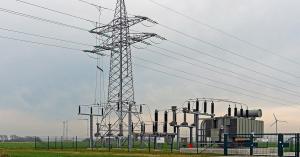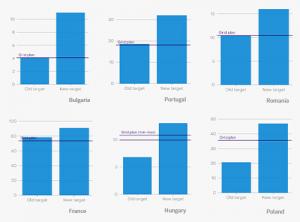
Grid Europe: accelerating the energy transition by 2030
To achieve the 2030 energy security and climate ambitions, the European grid has a transition to renewable energy generation and a focus on wind and solar.
LONDON, UNITED KINGDOM, April 16, 2024 /EINPresswire.com/ -- The energy crisis and Russia's invasion of Ukraine have turbocharged Europe's shift from fossil fuels to renewables.
The results of this are already evident, with renewables rising to a record 44% of the EU's electricity mix and fossil fuels dropping by 19% to their lowest-ever level in 2023.
However, as clean technology investment reaches record highs, its deployment has started to come up against previously overlooked challenges. One of these challenges is a lack of grid capacity.
In some places, grid capacity is reaching its limit due to insufficient expansion, aging infrastructure, and inadequate flexibility.
Signs of stress in the form of lengthy grid connection queues and increasing curtailment of renewable electricity have drawn attention to the central role of grids in decarbonizing Europe's economy, pushing grids far up the political agenda for perhaps the first time.
Some grid development plans may not meet Europe's 2023 climate targets
Analysis of grid plans shows that planned transmission grid developments may be insufficient to cater to the renewable uptake that is necessary to achieve energy policy targets.
The energy scenarios in the latest grid plans from European TSOs show a high degree of misalignment with current policy targets in certain countries.
This is particularly evident in the foreseen installed capacity of wind and solar in 2030.
Since it takes far longer to increase grid capacity than it does to deploy wind and solar projects, grids may not be prepared to meet the scale of future increases.
"We can't afford to overlook grids. They risk holding Europe's supercharged energy transition back if plans aren't updated. Making sure solar and wind can connect to the system is as critical as the panels and turbines themselves. There is no transition without transmission." said Elisabeth Cremona, Energy and Climate Data Analyst.
However, analysis shows that this is not always the case, with some plans significantly undershooting the national targets.
Wind and solar capacities from the 26 grid plans with adequate data available were compared to their respective 2030 country targets.
Of these, ten use scenarios with lower ambition than targets. Among the rest, 13 grid plans were found to be well aligned, and four used more ambitious scenarios.
Of the ten of 26 grid plans that are based on scenarios where the combined capacity of wind and solar is lower than established national policy; the total difference is 65 GW.
This is equivalent to about 8% of the total capacity targeted by these countries. While that may not seem significant at a pan-European level, the divergence at the national level in certain countries is concerning.
For instance, Bulgaria's grid development plan assumes 4.1 GW wind and solar in 2030 but the country’s policy target is more than 11 GW, a difference of 63%.
In the realm of transmission system operators (TSOs), the efficacy of future infrastructure projections hinges on the ambitiousness of the scenarios they consider.
When assessments lean toward the conservative side, there's a risk of neglecting essential investments required to align with policy objectives, consequently stalling development.
This oversight poses a tangible obstacle to the anticipated expansion of wind and solar energy, hindering the transition process rather than facilitating it.
Nevertheless, this trend isn't pervasive across the board.
Noteworthy exceptions include Croatia, Denmark, Finland, and the Netherlands, where plans are formulated based on more robust scenarios featuring higher capacities for wind and solar energy integration.
These scenarios surpass existing targets by substantial margins, with projections ranging from 50% above for Denmark to a remarkable 200% for Finland.
In these select countries, grid development strategies are gearing up for a significant surplus—81 GW more—of wind and solar energy compared to national policy benchmarks.
Such ambitious plans signal a critical need for substantial investments, to the tune of nearly €600 billion, into high-voltage infrastructure encompassing power lines, transformers, and transmission infrastructure by 2030.
Addressing this imperative is paramount for both the current and incoming European Commission, as well as EU Member States.
Without a comprehensive focus on enhancing transmission capabilities, the envisioned energy transition remains unattainable.
What makes up the grid?
Large-scale generation
electricity is generated in power plants - such as wind and solar farms, and thermal and hydro units.
Large-scale generators are typically connected directly to the transmission grid, other generators such as small solar PV units are connected to the distribution grid.
Transmission
The skeleton of the electricity grid - high-voltage lines that connect main substations, carrying electricity between key generation and demand centers.
This also includes cross-border connections between neighboring countries.
Distribution
medium and low-voltage lines and transformer stations. The distribution network carries electricity from transmission grid nodes to end users.
Consumption
End users of electricity such as households, factories, offices, or public administration buildings.
A complete power grid contains a variety of cables and their accessories, including bare conductors, ABC cables, low-voltage power cables, and medium-voltage power cables.
Bare conductors include AAC, AAAC, and ACSR, these overhead aluminum conductors are used as transmission and distribution lines.
All aluminum conductors consist of one or more strands of aluminum wire, depending on the specific application.
Aerial bundle cable is used for the distribution of low-power overhead networks in metropolitan, urban, and rural areas.
Low-voltage and medium-voltage cables are used to distribute electricity from substations to residential, commercial, and industrial areas.
Low voltage cables typically carry electricity at voltages up to 1000 volts, while MV cables handle voltages ranging from 1000 to 35,000 volts.
High-performing cables can enhance the efficiency of the grid, reducing maintenance costs in the long run and contributing to the upgrading of the grid.
Meanwhile, the EU should develop clean energy vigorously to fulfill investment expectations.
Lisa
Huadong Cable Group Co., Ltd
+86 132 7156 7856
sales@huadongcable.fr
Visit us on social media:
Facebook
Twitter
LinkedIn
Instagram
YouTube
TikTok
Other
High quality power cables
EIN Presswire does not exercise editorial control over third-party content provided, uploaded, published, or distributed by users of EIN Presswire. We are a distributor, not a publisher, of 3rd party content. Such content may contain the views, opinions, statements, offers, and other material of the respective users, suppliers, participants, or authors.




